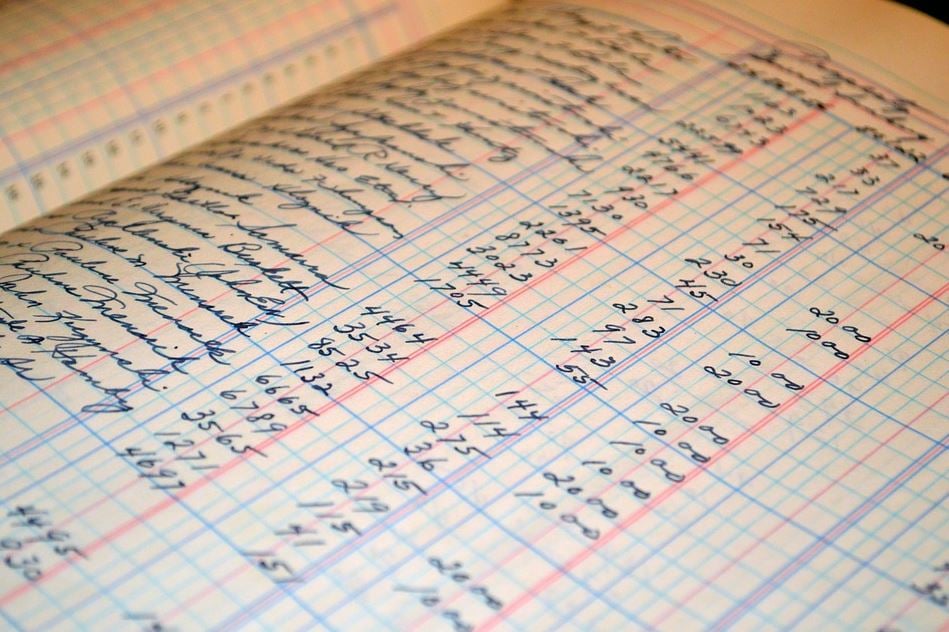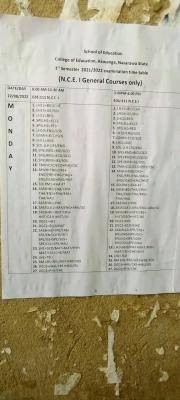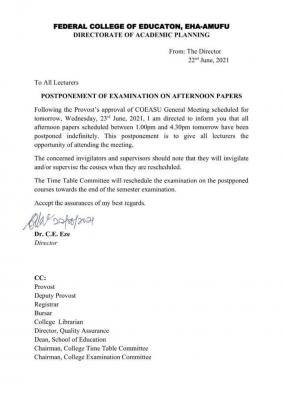
Book Keeping lesson note for SS2 First Term is now available for free. The State and Federal Ministry of Education has recommended unified lesson notes for all secondary schools in Nigeria, in other words, all private secondary schools in Nigeria must operate with the same lesson notes based on the scheme of work for Book Keeping.
Book Keeping lesson note for SS2 first Term has been provided in detail here on schoolgist.ng

For prospective school owners, teachers, and assistant teachers, Book Keeping lesson note is defined as a guideline that defines the contents and structure of Book Keeping as a subject offered at SS level. The lesson note for Book Keeping for SS stage maps out in clear terms, how the topics and subtopics for a particular subject, group works and practical, discussions and assessment strategies, tests, and homework ought to be structured in order to fit in perfectly, the approved academic activities for the session.
To further emphasize the importance of this document, the curriculum for Book Keeping spells out the complete guide on all academic subjects in theory and practical. It is used to ensure that the learning purposes, aims, and objectives of the subject meant for that class are successfully achieved.
Book Keeping Lesson note for SS2 carries the same aims and objectives but might be portrayed differently based on how it is written or based on how you structure your lesson note. Check how to write lesson notes as this would help make yours unique.
The SS2 Book Keeping lesson note provided here is in line with the current scheme of work hence, would go a long way in not just helping the teachers in carefully breaking down the subject, topics, and subtopics but also, devising more practical ways of achieving the aim and objective of the subject.
The sudden increase in the search for SS2 Book Keeping lesson note for First Term is expected because every term, tutors are in need of a robust lesson note that carries all topics in the curriculum as this would go a long way in preparing students for the West African Secondary Examination.
This post is quite a lengthy one as it provides in full detail, the government-approved lesson note for all topics and sub-topics in Book Keeping as a subject offered in SS2.
Please note that Book Keeping lesson note for SS2 provided here for First Term is approved by the Ministry of Education based on the scheme of work.
I made it free for tutors, parents, guardians, and students who want to read ahead of what is being taught in class.
SS2 Book Keeping Lesson Note (First Term) 2024
SCHEME OF WORK
SUBJECT: BOOK-KEEPING
CLASS: SS 2
- Revision of 1stTerm work
- Classes of ledger
- State classes of ledger
- Identification of the column of a ledger
- Classes of ledger
- Posting of transaction into a ledger
- Working exercise.
- Three column cash book
- Explain the column cash book
- Identification of the columns of a three column cash book.
- Three column cash book
- Differentiate between single, double and three columns cash book.
- Three column cash book
- Preparation of three column cash book
- Three column cash book
- Preparation of three column cash book working exercise
- Stock valuation
- Meaning, explain stock valuation
- Purposes of stock valuation
- Stock Valuation
- List different stock valuation method.
- Computation of stock valuation.
- Stock Valuation
- Computation of stock valuation
- Working exercises on stock valuation
WEEK TWO (2)
CLASSES OF LEDGER
THE LEDGER
This is the principal book in which accounts are kept. These accounts are usually referred to as ledger accounts. They are so called because each occupies a specific page a number of pages or a section of a page in the ledger.
Note: A balance Sheet, on the other hand is not a ledger account. But a statement of assets and liabilities at a point in time compiled from the list of balances taken from the ledger.
To make references to account easy, the ledger pages are usually numbered consecutively, each page is called a ‘folio’ and the number on it a ‘folio number’
The following is a specimen of a simple ledger.
| Date | Particular | Folio | Amount | Date | Particular | Folio | Amount |
Detailed Features of the Ledger
- Folio Column: This column indicates the folio (or page) in which the other half of the double entry has been recorded.
- Date Column: This is for entering the year, month and date on which the transaction occurs.
iii. Particulars Column: The nature of the transaction is entered in this column. Usually, it is the name of the account in which the other half the double entry is made. The account is easily identified by folio number.
- Amount Column: The amount of the transaction is entered in this column.
Note: Debit entries are made on the left side of the page while credit entries are made on the right side. The debit side is distinguished from the credit side by the letters Dr and Cr respectively.
WEEK THREE (3)
CLASSIFICATION OF LEDGER ACCOUNTS.
There are two main classes of ledger accounts. These are
- Personal Accounts
- Impersonal Account.
Impersonal Accounts are sub-divided into two, namely real account and nominal account.
(1) Personal Accounts: These are accounts in which transactions with persons and other businesses and organizations are recorded. Debtors and creditors’ accounts are typical examples. If the balances are due for settlement within a year, they represent current assets and current liabilities respectively.
Note: The capital account is a special kind of personal account. It is an account in which the value of the proprietor’s investment in the business is recorded.
It is therefore the proprietor’s or owner’s personal account.
(2) Impersonal Accounts: These are accounts which record transactions of either “real or nominal” nature. Impersonal accounts are therefore usually divided into “real” and nominal accounts.
(i) Real Account: These record transactions relating to property and material objects. Examples of such accounts include; Land and buildings, cash at bank, motor vehicles, furniture and fittings, stock of goods for resale. They are known as tangible assets because we can see and touch them. All accounts that relate to tangible assets are therefore real accounts.
(ii) Nominal Account: Nominal accounts relate to items that exist in name only. You cannot touch or see such items as they have no physical form. Examples include income, expenses, losses and gains which have been incurred. Thus, wages and salaries general expenses, rents and rates, interest and dividends received (or paid for), are examples of nominal accounts.
THE DIVISION OF THE LEDGER
A business that is fairly small can conveniently maintain a single ledger in which transactions are recorded by one clerk. But, if the firm is bigger in size, such practice can create problems. First, the work might be too much for one clerk to handle effectively. Secondly, the book can become too unwieldy to permit the extraction of information in time, if and when the need arises. To minimize these problems, it is often considered necessary to divide the ledger into several parts, each concern with specific classes of transactions. The usual divisions of the ledgers are as follows:
(1) SALES LEDGER
This is also called “sold ledger” or “debtors ledger”. The sales ledger contains a separate account for each individual to whom goods have been sold, or for whom services have been performed on credit.
The sales ledger is referred to as the debtors’ ledger because it contains the personal accounts of debtors to the business.
Interpretation of a sale ledger account
The following is an example of a debtor’s account in the sales ledger.
Dr. S. Osakwe Folio 8 Cr.
| Date | Particulars | Folio | Amount N | Date | Particulars | F. | Amount N |
| 19X 8 | 19X 8 | ||||||
| Oct. 1 | Balance | b/d | 800 | Oct. 15 | Cash | 2 | 720 |
| Oct. 20 | Sales | 600 | Oct. 15 | Discount Allowed | 6 | 80 | |
| Oct. 24 | Sales Under Change on Sales of Oct. 20 | 10 | 10 | ||||
| Oct. 23 | Returns Inwards | 9 | 150 | ||||
| Oct. 31 | Balance | c/d | 460 | ||||
| 1,410 | 1,410 | ||||||
| Nov. 1 | Balance | b/d | 460 |
The entries in the account may be interpreted as follows:
- S. Osakwe’s account is kept on page 8 of the sales ledger.
- On 1stOct., 19×8, he owed N800 to the business being as the balance unpaid at the end of the previous month. This conclusion is derived from the debit balance in his account on 1stOctober, 19×8.
iii. On 15th October, he paid N720, having cash deducted as a discount of N80 (i.e. 10% of N800) from his debt for paying promptly. The cash and discounts allowed accounts are kept on pages (i.e. folio 2 and 6 of the relevant ledger respectively.
- On Oct. 20, goods worth N600 were sold to him on credit. This fact was stated on the invoice sent to him with goods. The sales account is maintained on page 10 of the relevant ledger.
- Good worth N150 were returned by him on 23rdOct. and he was sent a credit not for N150 on the same date. The returns inwards account is maintained on folios of the relevant ledger.
- On 24thOctober, it was discovered that Osakwe should have been changed N610 instead of N600 for the sale on 20thOctober. He was therefore sent a debit note of N10 for this undercharge.
vii. At the end of the month, Osakwe owed N460. If a balance sheet is prepared on 31st October this amount will be included in the amount shown as debtors under current assets.
- PURCHASE LEDGER
This is called a “bought Ledger” or “creditors Ledger”. It contains the personal accounts of creditors. A creditor is a supplier from whom goods or services have been obtained to be paid for at an agreed future date.
Until payment is made, the amount owing is reflected by a credit balance in the personal account of the supplier in the ledger. Such an amount is normally classified under current liabilities in the balance sheet.
Interpretation of a purchases ledger account.
The following is an example of a creditor’s account in the purchases ledger.
Dr. R. Makinde Cr.
| Date | Particulars | Folio | Amount N | Date | Particulars | F. | Amount N |
| 19X 8 | 19X 8 | ||||||
| May 15 | Cash | 2 | 1,080 | May 1 | Balance | b/d | 755 |
| May 15 | Discount received | 7 | 120 | May 12 | Purchases | 4 | 445 |
| May 13 | Purchases | 4 | 1,000 | ||||
| May 16 | Purchases returns | 5 | 100 | ||||
| May 31 | Balance | c/d | 900 | ||||
| 2,200 | 2,200 | ||||||
| June 1 | Balance | b/d | 900 | ||||
- The folio numbers and columns have the same interpretation as in the preceding example.
- May 1 on this date R. Makinde was owed N755. This is reflected by a credit balance in his personal account.
iii. May 12 & 13. Goods were bough on credit from R. Makinde on these dates for N445 and N1000 respectively.
- May 15 N1,080 was paid to Makinde in cash in full settlement of the amount owed at the beginning of the month and credit purchases made on may 12thfor Making this payment promptly, a discount of 10% on (N755 + N445), N1,200 was received.
- May 16th, of the goods bought on May 13th, goods worth N100 were returned to Makinde on this date probably because they were faulty or damaged.
- At the end of the month, N900 was owing to Makinde.
- GENERAL LEDGER:This is the ledger in which most deal and nominal accounts are kept. For example, the discount allowed and discount received accounts would normally be kept in the general ledger as would many other accounts.
- PRIVATE LEDGER:This is a ledger which, for confidential and security reasons, is kept by either the proprietor or the accountant outside the reach of office staff. Examples of accounts which would normally be kept in such a ledger include capital, drawings and profit and loss account.
WEEK 4 – 7
THE THREE – COLUMN CASH BOOK
This is similar to the two column cash book except that the discount column is added to both the debit side and the credit side. The debit side, it will be recalled, records receipts while the credit side records payments. The purpose of the discount column in the debit side is, therefore, to record discounts which are allowed to customers when the business receives cash from them. Similarly, the discount column on the credit side is for discounts which the business receives from its suppliers when payments are made to them.
Example
The cash book of S. Essien is maintained with cash bank and discount columns. During the month of March, 19×9, the following transactions took place.
March 1. Cash balances in hand N100, and at bank N1,220.
March 2. Paid J. Okonedo by cheque N105 in full settlement of his account for N110.
March 5. Cash purchases N48, and purchases by cheque N850.
March 10. Cash sales N780
March 12. Cash paid into bank N560
March 15. Received cheque from M. Dantata N650 on account.
March 18. Received cheque from j. Robens N65 in full settlement of his account for N68.
March 23. Paid N650 into bank.
March 26. Cash sales N400
March 28. Drew cash from bank for office use N200.
You are required to balance the cash book and bring down the balances of cash in hand and at bank on 31st March, 19×9.
WEEK EIGHT (8) TO TEN (10)
STOCK VALUATION
Methods of stocks valuation are devices which aim to deal with some of the problems. W shall consider some of those commonly adopted.
(I) FIRST-IN-FIRST OUT (FIFO) METHOD.
This method assumes as the name indicates that items of stock were sold during the year in the order in which they were originally bought. Goods that were bought first (FIRST-IN) were those that were sold first, or issued first for production (FIRST-OUT). It follows then that items of closing stock will be made up of those bought most recently.
Example:
A firm had a stock of 100 items at the beginning of an accounting year. The items were valued at N2.00 each purchases during the year were as follows.
N
January 200 units at N3 each 600
June 300 units at N4 each 1,200
Dec. 100 units at N5 each 500
300 2,300
500 units were sold during the year for N3,500. Find
(a) The value of closing stock of goods and
(b) The cost of goods sold.
If FIFO method of valuing closing stock is used.
SUGGESTED SOLUTION
(a) Value of closing stock
Since the FIFO method of valuation is used, the closing stock of 200 units is made up of items bought most recently. Hence
N
100 units bough in June at N4 each 400
100 units bought in Dec. at N5 each 500
200 units of stock at end has a value of 900
(b) Cost of goods sold
Under FIFO, goods are deemed to be sold in the order in which the items bought first being sold first. Hence
N
100 units sold from opening stock cost N2 each 200
200 units sold from January purchases N3 each 600
200 units sold from June purchases cost N4 each 800
500 1,600
(II) LAST-IN-FIRST OUT (LIFO) METHOD.
This takes the opposite view to the FIFO method and assumes that goods sold during the period are first taken from those most recently purchased. On the basis of this assumption, the closing stock of goods is taken to comprise items bought first.
Example:
Same as under FIFO
SUGGESTED SOLUTION
(a) Value of closing stock
N
100 units held at the beginning values at N2 each 200
100 units bought in January at N3 each 300
200 units of stock at end has a value of 500
(b) Cost of goods sold
N
100 units bought in Dec. at N5 each 500
300 units bought in June at N4 each 1,200
100 units bought in Dec. at N3 300
500 2,000
(III) WEIGHTED AVERAGE COST METHOD.
This simply uses the weighted average method to value closing stock and cost of goods sold.
Example:
Same as in under FIFO
SUGGESTED SOLUTION
Months Units Unit cost Total cost(N)
January (Opening) 100 x 2 200
January (Purchases) 200 x 3 600
June (Purchases) 300 x 4 1,200
June (Purchases) 100 x 5 500
December (Purchases) 700 2,500
Weighted Average cost: N2,500÷700=N3.57
(a) Value of closing stock
N
No of units of closing stock 200
Weighted average cost per unit 3.57
Value of closing stock 3.57×200
= 714
(b) Cost of Goods sold
N
Number of units sold 500
Weighted average cost per unit sold 3.57
Cost of all units sold 3.57×500
= 1,785
ASSIGNMENT
- Explain why the valuation of stock is necessary in a business.
- Outline and discuss the common problems associated with stock valuation.
- Using the following date, calculate and show
(a) The value of closing stock
(b) The cost of goods sold under
(i) FIFO (ii) LIFO and (iii) Weighted average cost method of stock valuation.
Opening stock: 10 units valued at N20 each.
Purchases
January 20 units at N40 each
March 20 units at N34 each
Sept 40 units at N40 each.
Sales
April 16 units for N46 each
December 48 units for N56 each
Hope you got what you visited this page for? The above is the lesson note for Book Keeping for SS2 class. However, you can download the free PDF file for record purposes.
If you have any questions as regards Book Keeping lesson note For SS2 class, kindly send them to us via the comment section below and we shall respond accordingly as usual.



